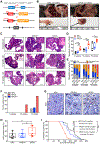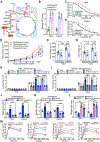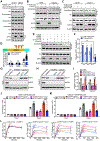Metabolic Rewiring by Loss of Sirt5 Promotes Kras-Induced Pancreatic Cancer Progression
- PMID: 34245764
- PMCID: PMC8546779
- DOI: 10.1053/j.gastro.2021.06.045
Metabolic Rewiring by Loss of Sirt5 Promotes Kras-Induced Pancreatic Cancer Progression
Abstract
Background & aims: SIRT5 plays pleiotropic roles via post-translational modifications, serving as a tumor suppressor, or an oncogene, in different tumors. However, the role SIRT5 plays in the initiation and progression of pancreatic ductal adenocarcinoma (PDAC) remains unknown.
Methods: Published datasets and tissue arrays with SIRT5 staining were used to investigate the clinical relevance of SIRT5 in PDAC. Furthermore, to define the role of SIRT5 in the carcinogenesis of PDAC, we generated autochthonous mouse models with conditional Sirt5 knockout. Moreover, to examine the mechanistic role of SIRT5 in PDAC carcinogenesis, SIRT5 was knocked down in PDAC cell lines and organoids, followed by metabolomics and proteomics studies. A novel SIRT5 activator was used for therapeutic studies in organoids and patient-derived xenografts.
Results: SIRT5 expression negatively regulated tumor cell proliferation and correlated with a favorable prognosis in patients with PDAC. Genetic ablation of Sirt5 in PDAC mouse models promoted acinar-to-ductal metaplasia, precursor lesions, and pancreatic tumorigenesis, resulting in poor survival. Mechanistically, SIRT5 loss enhanced glutamine and glutathione metabolism via acetylation-mediated activation of GOT1. A selective SIRT5 activator, MC3138, phenocopied the effects of SIRT5 overexpression and exhibited antitumor effects on human PDAC cells. MC3138 also diminished nucleotide pools, sensitizing human PDAC cell lines, organoids, and patient-derived xenografts to gemcitabine.
Conclusions: Collectively, we identify SIRT5 as a key tumor suppressor in PDAC, whose loss promotes tumorigenesis through increased noncanonic use of glutamine via GOT1, and that SIRT5 activation is a novel therapeutic strategy to target PDAC.
Keywords: GOT1; Glutamine Metabolism; Glutathione Metabolism; Pancreatic Cancer; SIRT5.
Copyright © 2021 The Authors. Published by Elsevier Inc. All rights reserved.
Conflict of interest statement
Figures







Comment in
-
SIRT5's GOT1 up on PDAC.Gastroenterology. 2021 Nov;161(5):1376-1378. doi: 10.1053/j.gastro.2021.07.020. Epub 2021 Jul 16. Gastroenterology. 2021. PMID: 34280390 Free PMC article. No abstract available.
References
Publication types
MeSH terms
Substances
Grants and funding
LinkOut - more resources
Full Text Sources
Medical
Molecular Biology Databases
Miscellaneous

